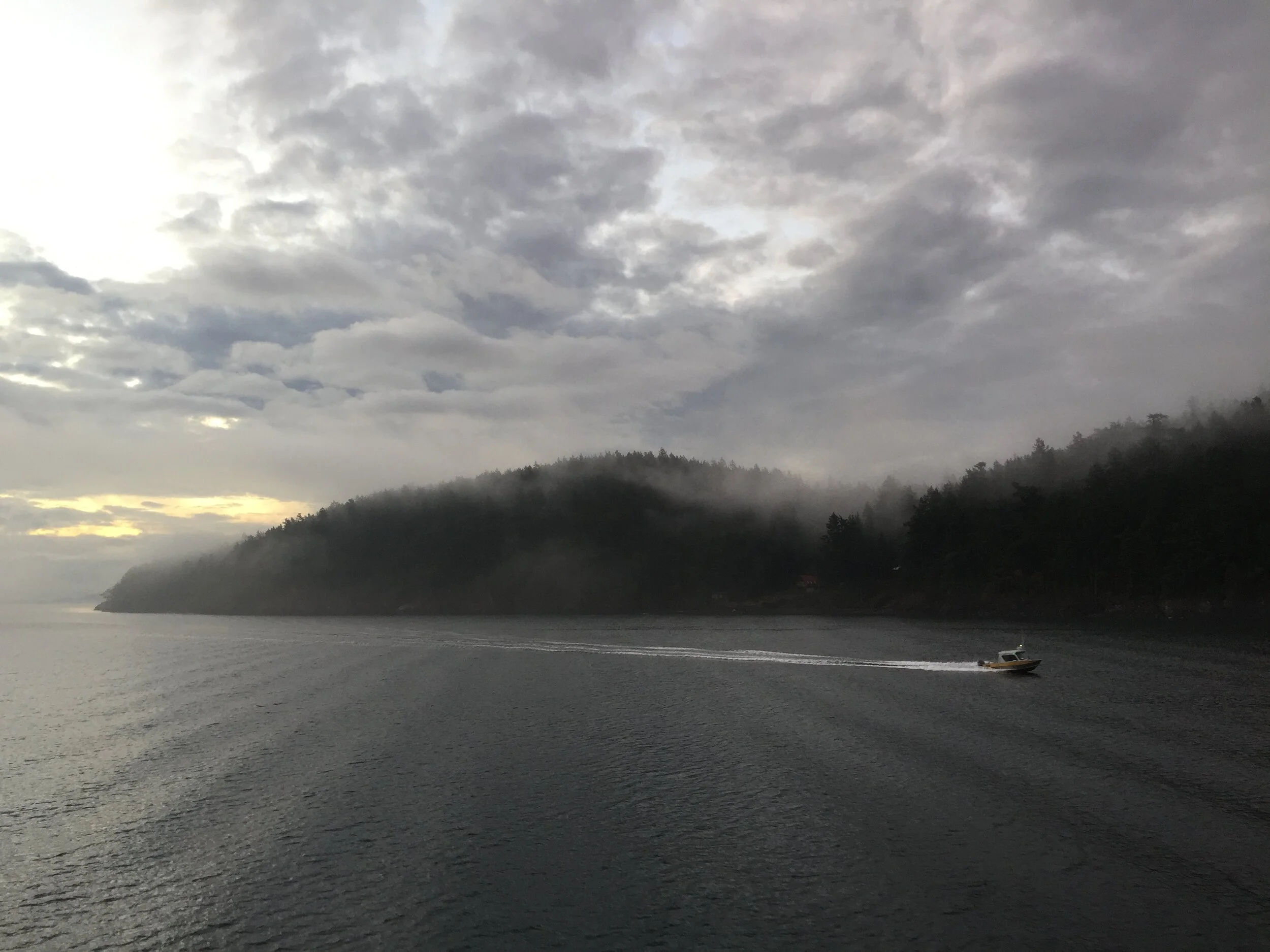Introductions
A misty dawn on the San Juan - Anacortes ferry
The temperature dipped into the thirties last night, colder than forecast. I’ve harvested the last of the Japanese indigo and extracted the pigment. The dahlias are still abundant; I’m thinking of making one final, concentrated dyebath with them and then freezing it for later this winter when I have more yarn to dye. The lambs we sheared in September have had to endure wet weather and wind earlier than usual this autumn; building them a shelter on the north side of the farm vaulted up the priority list. Every turn toward winter brings the scurry to lay in enough hay and straw, and when you farm on an island this task is complicated by the challenge and expense of bringing every bale across by ferry.
This morning it was my turn for the final hauling day; I rose before 4:30 and loaded our flatbed cabover on the first boat. The drive from Anacortes down to Whidbey Island is stunning. Even if you’re short of coffee, you’ll feel properly alive when your truck is jouncing over a narrow two-lane bridge built in 1934, 180 feet above the roiling currents of Deception Pass. The farm that supplies our hay and barley is beautifully situated amidst a quilt of fertile fields in a natural basin that tips gently down to the sea, with a view of the Olympic range rising sheer across the strait. Today I’m buying “diet hay” for the mustangs and to round out the roughage in the sheep rations. It’s hay we should be able to grow in our own pastures, but we haven’t cut any for the past two years while we experiment with intensively managed grazing, fertilizing, and overseeding to restore the fertility of our land.
The ferries have switched to their fall sailing schedule, which means I can’t get home until mid-afternoon. What to do with a few extra hours now that I’m back in Anacortes with 102 bales securely strapped to my truck? A walk along the shore path, a spot of knitting on a driftwood log in the chilly sunshine, watching the sea ducks dabble amongst the old pilings, and writing the first newsletter to announce our little wool company to the world.
San Juan Woolworks is a dream that’s been marinating since my family took up Oak Knoll Farm and assumed husbandry of the North Country Cheviot sheep flock established here by Joan Roberts more than forty years ago. If the farm hadn’t come with sheep, I probably would have contented myself with a tiny backyard flock of woolies—four or five Shetlands, perhaps. I could have puttered with a few fleeces per year, hand spinning one or two, maybe giving away another to a friend or even selling one from time to time. Becoming stewards of a flock with a history and a web of relationships with other shepherds around the county and beyond was a proposition freighted with community implications. Would we carry on the work to breed quality rams for our neighbors and preserve the genetics Joan honed over so many years? What would it look like to try to breed for wool quality, which isn’t normally the focus for Cheviots in America? How could we try to make it worthwhile for other San Juan Island shepherds to attend to wool rather than turning to hair sheep breeds now that it costs more to pay the shearer than you can earn for the clip on the commercial market?
Lopez, the next island over, is a shining example of how a small but passionate fiber company can help to sustain community woolgrowing over decades. Maxine Bronstein and Debbie Hayward of Island Fibers buy a large portion of the annual clip from a number of Lopez shepherds, take the wool to the mill, dye the yarn themselves, weave beautiful textiles, and travel to festivals and shows to sell their wares. They reserve the best fleeces for handspinners. Their steady support, fair prices, and guidance to shepherds for improving their fleeces year over year have kept Lopez’s wool scene strong while also giving customers access to fiber that isn’t often available in yarn shops.
We hope San Juan Woolworks will grow to play a similar role for woolgrowers on our island. Our Haven line uses the best of the North Country Cheviot wool from our own flock along with fleeces from a North Country x Suffolk flock tended by Mary Jane Anderson and Nancy Larsen in the next valley over. We hope to build relationships with other shepherds whose sheep fit the same breed profile and exhibit similar fleece qualities: Down-type loft and a staple length between 4 and 5 inches, strong and reasonably clean. And we are excited to find new fibers to work with as our friends experiment with different crosses. We look forward to sharing honest, hearty, sustainable wool with our supporters in 2020 and beyond!
In the meantime, we always welcome visitors to the farm. Our 2019 lamb crop contains some pretty friendly little characters, and our head ewe, Eleanor, has recently decided that humans are for delivering chin scratches as well as food. And if you’re not close enough to come to the islands in person, you can keep up with us via our new website, sanjuanwoolworks.com, and on Instagram @sanjuanwoolworks.
Andromeda and Cassiopeia, 2019 North Country Cheviot ewe lambs at Oak Knoll Farm

